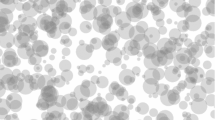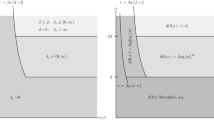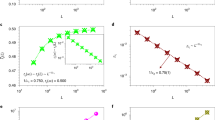Abstract
We prove that the Poisson Boolean model, also known as the Gilbert disc model, is noise sensitive at criticality. This is the first such result for a Continuum Percolation model, and the first which involves a percolation model with critical probability p c ≠ 1/2. Our proof uses a version of the Benjamini-Kalai-Schramm Theorem for biased product measures. A quantitative version of this result was recently proved by Keller and Kindler. We give a simple deduction of the non-quantitative result from the unbiased version. We also develop a quite general method of approximating Continuum Percolation models by discrete models with p c bounded away from zero; this method is based on an extremal result on non-uniform hypergraphs.
Similar content being viewed by others
References
R. Aharoni, A problem in rearrangements of (0,1) matrices, Discrete Mathematics 30 (1980), 191–201.
D. Ahlberg, Partially observed Boolean sequences and noise sensitivity, Combinatorics, Probability and Computing, to appear.
R. Ahlswede and G. O. H. Katona, Graphs with maximal number of adjacent pairs of edges, Acta Mathematica Academiae Scientiarum Hungaricae 32 (1978), 97–120.
K. S. Alexander, The RSW theorem for Continuum Percolation and the CLT for Euclidean minimal spanning trees, The Annals of Applied Probability 6 (1996), 466–494.
N. Alon and J. Spencer, The Probabilistic Method, 3rd edition, Wiley Interscience, New York, 2008.
P. Balister, B. Bollobás and M. Walters, Continuum Percolation with steps in the square or the disc, Random Structures & Algorithms 26 (2005), 392–403.
I. Benjamini and O. Schramm, Conformal invariance of Voronoi percolation, Communications in Mathematical Physics 197 (1996), 75–107.
I. Benjamini and O. Schramm, Exceptional planes of percolation, Probability Theory and Related Fields 111 (1998), 551–564.
I. Benjamini, G. Kalai and O. Schramm, Noise sensitivity of Boolean functions and applications to percolation, Institut des Hautes Études Scientifiques. Publications Mathématiques 90 (1999), 5–43.
I. Benjamini, O. Schramm and D. B. Wilson, Balanced Boolean functions that can be evaluated so that every input bit is unlikely to be read, In STOC’05: Proceedings of the 37th Annual ACM Symposium on Theory of Computing, ACM, New York, 2005, pp. 244–250.
C. Bey, An upper bound on the sum of squares of degrees in a hypergraph, Discrete Mathematics 269 (2003), 259–263.
B. Bollobás, Modern Graph Theory, 2nd edition, Springer, Berlin, 2002.
B. Bollobás and O. Riordan, The critical probability for random Voronoi percolation in the plane is 1/2, Probability Theory and Related Fields 136 (2006), 417–468.
B. Bollobás and O. Riordan, Percolation, Cambridge University Press, Cambridge, 2006.
J. Bourgain, J. Kahn, G. Kalai, Y. Katznelson and N. Linial, The influence of variables in product spaces, Israel Journal of Mathematics 77 (1992), 55–64.
E. I. Broman, C. Garban and J. E. Steif, Exclusion sensitivity of Boolean functions, Probability Theory and Related Fields 155 (2013), 621–663.
D. de Caen, An upper bound on the sum of squares of degrees in a graph, Discrete Mathematics 185 (1998), 245–248.
H. Chernoff, A Measure of Asymptotic Efficiency for Tests of a Hypothesis Based on the sum of Observations, Annals of Mathematical Statistics 23 (1952), 493–507.
E. Friedgut, Influences in product spaces: KKL and BKKKL revisited, Combinatorics, Probability and Computing 13 (2004), 17–29.
C. Garban, Oded Schramm’s contributions to noise sensitivity, The Annals of Probability 39 (2011), 1702–1767.
C. Garban, G. Pete, and O. Schramm, The Fourier spectrum of critical percolation, Acta Mathematica 205 (2010), 19–104.
E. N. Gilbert, Random plane networks, Journal of the Society for Industrial and Applied Mathematics 9 (1961), 533–543.
G. Grimmett, Percolation, 2nd edition, Springer-Verlag, Berlin, 1999.
O. Häggström, Y. Peres and J. E. Steif, Dynamical percolation, Annales de l’Institut Henri Poincaré. Probabilités et Statistiques 33 (1997), 497–528.
A. Hammond, G. Pete and O. Schramm, Local time on the exceptional set of dynamical percolation, and the incipient infinite cluster, submitted, arXiv:1208.3826.
J. Kahn, G. Kalai and N. Linial, The influence of variables on Boolean functions, in 29th Annual Symposium on Foundations of Computer Science, 1988, pp. 68–80.
N. Keller, A simple reduction from a biased measure on the discrete cube to the uniform measure, European Journal of Combinatorics 33 (2012), 1943–1957.
N. Keller and G. Kindler, Quantitative relation between noise sensitivity and influences, Combinatorica 33 (2013), 45–71.
N. Keller, E. Mossel and T. Schlank, A note on the entropy/influence conjecture, Discrete Mathematics 312 (2012), 3364–3372.
R. Meester and R. Roy, Continuum Percolation, Cambridge University Press, Cambridge, 1996.
M. V. Menshikov and A. F. Sidorenko, Coincidence of critical points in Poisson percolation models, Rossiıskaya Akademiya Nauk. Teoriya Veroyatnosteı i ee Primeneniya, 32 (1987), 603–606.
R. O’Donnell, Computational applications of noise sensitivity, Ph.D, thesis, MIT, 2003.
R. E. A. C. Paley, A remarkable series of orthogonal functions, Proceedings of the London Mathematical Society 34 (1932), 241.
R. Roy, The Russo-Seymour-Welsh theorem and the equality of critical densities and the dual critical densities for continuum percolation, The Annals of Probability 18 (1990), 1563–1575.
O. Schramm and J. Steif, Quantitative noise sensitivity and exceptional times for percolation, Annals of Mathematics 171 (2010), 619–672.
J. Steif, A survey of dynamical percolation, in Fractal Geometry and Stochastics IV, Progress in Probability, Vol. 61, Birkhäuser, Basel, 2009. pp. 145–174.
M. Talagrand, Concentration of measure and isoperimetric inequalities in product spaces, Institut des Hautes Études Scientifiques. Publications Mathématiques 81 (1995), 73–205.
J. L. Walsh, A closed set of normal orthogonal functions, American Journal of Mathematics 45 (1923), 5–24.
Author information
Authors and Affiliations
Corresponding author
Additional information
Research supported in part by: (DA) The Royal Swedish Academy of Sciences; (EB) The Göran Gustafsson Foundation for Research in Natural Sciences and Medicine; (SG) CNPq bolsa PDJ; (RM) CNPq bolsa de Produtividade em Pesquisa.
Rights and permissions
About this article
Cite this article
Ahlberg, D., Broman, E., Griffiths, S. et al. Noise sensitivity in continuum percolation. Isr. J. Math. 201, 847–899 (2014). https://doi.org/10.1007/s11856-014-1038-y
Received:
Revised:
Published:
Issue Date:
DOI: https://doi.org/10.1007/s11856-014-1038-y




